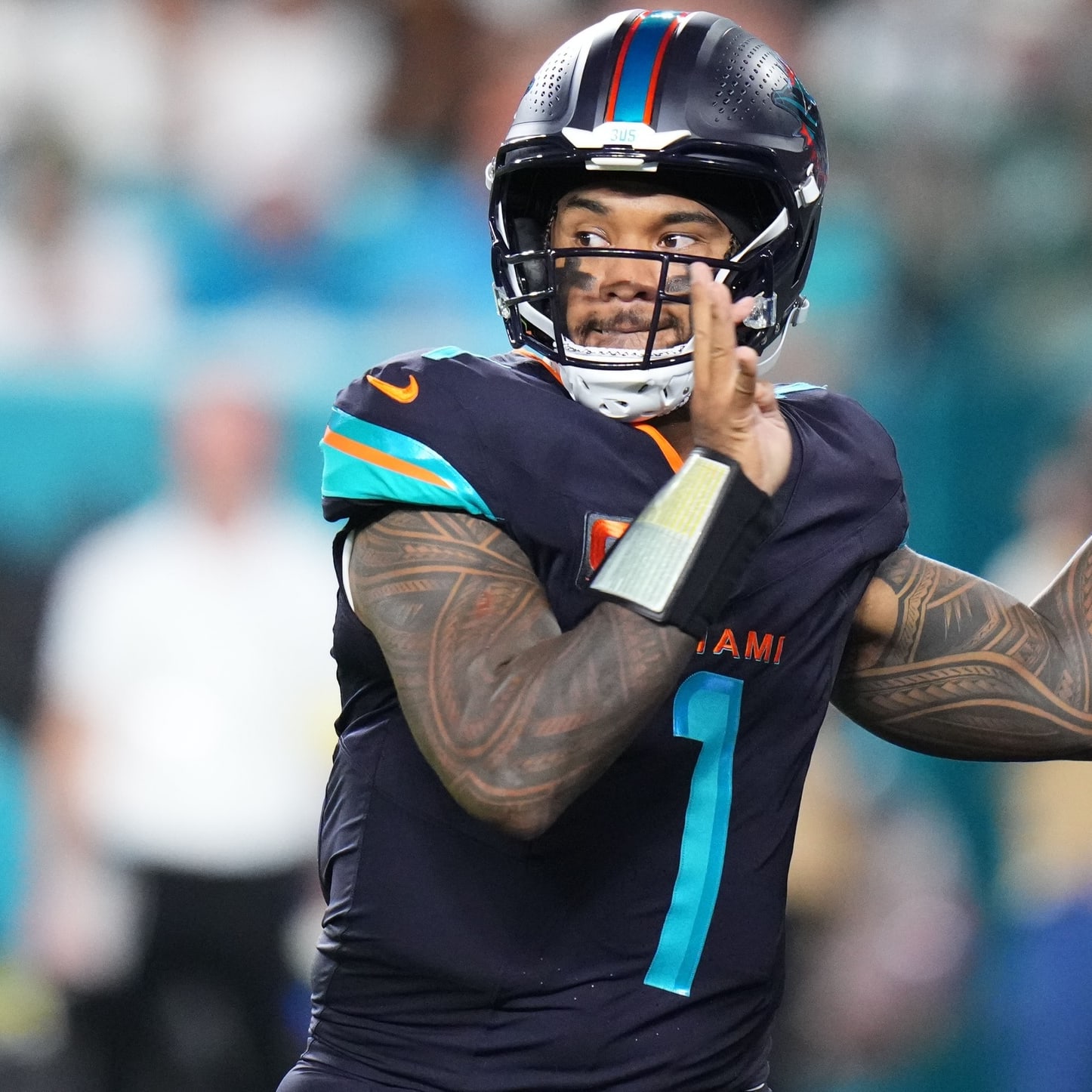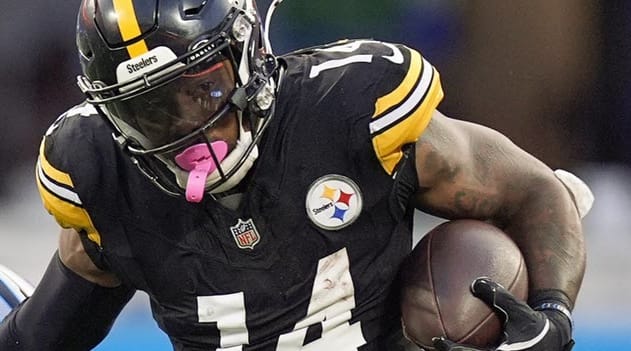The following rookie top 50 is for 1QB leagues, so move up the quarterbacks if you're wondering about superflex or two-QB. Despite the ordered list, players are meant to be mostly interchangeable within their tiers. This list will be updated after the draft.
Tier 1
- Breece Hall, RB, Iowa State
Hall isn't that strong of a 1.01 compared to some other years, but he's still a totally qualified candidate for the title after displaying high-volume, high-efficiency production over three seasons. That includes plenty of work as a pass catcher, catching 82 receptions on 99 targets over 36 games. Stellar production paired with a good frame (5-foot-11, 217 pounds) and athleticism (4.39-4.44 40) makes Hall a good bet to provide high volume usage at above average efficiency.
Projected round: Top 40
Tier 2
2. Drake London, WR, USC
London could join Hall in the first tier with a strong pro day showing, as he didn't do any testing at the combine after checking in at 6-foot-4, 219 pounds. He would have to test poorly to fall into the third tier, however. London's workout is scheduled for April 5.
Projected round: 1
3. Chris Olave, WR, Ohio State
Olave's 4.39-second 40 at 6-foot, 189 pounds is a solid time and gives him the wheels necessary to project as a strong downfield threat in the NFL. Olave was the more outside, downfield-oriented receiver between himself and teammate Garrett Wilson, who functioned more as a yards-after-the-catch target.
4. Garrett Wilson, WR, Ohio State
Wilson's 4.37-second 40 is a bit faster than Olave's, but at a lighter 183 pounds Wilson's weight-adjusted speed grades almost identically. Similar frame/speed aside, Wilson might be the preferable option for teams looking for yards after the catch in the underneath and middle of the field. Both should go in the first round.
Projected round: 1
5. Jameson Williams, WR, Alabama
Williams' torn ACL will prevent him from testing at any point in the draft. Still, Williams is believed to have speed in the 4.35 range, and his production at Alabama was outrageous. The only real concern with him is his skinny frame at 6-foot-2, 180 pounds, but his incredible production at Alabama implies that he has a high enough sum of traits to withstand a frame that otherwise might be 'too skinny.'
Projected round: 1
6. Treylon Burks, WR, Arkansas
Burks' 4.55-second 40 at the combine wasn't bad, but it was still short of what he needed to claim a spot in the first tier. Now he blends in with other four receivers in this tier, though he still certainly stands out build-wise at 6-foot-2, 225 pounds. Burks has that market cornered still, at least.
Projected round: Top 40
7. Malik Willis, QB, Liberty
There is some ugly footage in Willis' collegiate career at Liberty, but the supporting cast around him was lacking and he has rare athletic tools with which to project skills growth with a little luck. At the worst Willis should prove the league's second-most dangerous runner at quarterback behind Lamar Jackson.
Projected round: Top 10
Tier 3
8. Kenneth Walker, RB, Michigan State
It's worth moving Walker up to Tier 2 if he lands with a team where he projects as starter, but as things stand there's a pretty substantial risk his short-term usage cap is in a rotation. Walker's originally reported 40 time of 4.46 at 211 pounds is adequate but only that, and he's inexperienced as a pass catcher. He's pretty fast but also lighter than average, so his density-adjusted athleticism is only decent. If Walker can turn corners and break angles like he did at Michigan State, though, then he should prove an effective runner in the NFL, including as a starter. Walker was uniquely explosive over a large volume of rushing work last year, and his work with Wake Forest before that was plenty good too. He perhaps grades similarly to Miles Sanders, though with fewer ball security/hands concerns.
Projected round: 2
9. Jahan Dotson, WR, Penn State
NFL.com's comparison for Dotson hits the bull's eye: Emmanuel Sanders. He's light at 178, but his 4.43 40 should be good enough to threaten downfield from outside and he otherwise is adept at drawing targets in the underneath and intermediate. Dotson's production was excellent at Penn State and there's reason to suspect he'll make an immediate impact as a rookie.
Projected round: Top 50
10. George Pickens, WR, Georgia
Pickens' true freshman season at Georgia was memorably good, to the extent that it marked him as a standout NFL prospect by itself as a data point. The problem is that he hasn't added any clearly positive data points to his prospect profile since that true freshman year, and his athletic testing at the combine was actually disappointing. Pickens' athletic profile is disturbingly similar to that of Josh Reynolds, who was actually very productive at Texas A&M before otherwise disappointing with the Rams. With that said, Pickens' 4.47 at 195 pounds is a meaningful difference from Reynolds' 4.52 at 194 pounds. Pickens is also an underclassman, whereas Reynolds was a fourth-year player.
Projected round: Top 50
11. Khalil Shakir, WR, Boise State
Shakir posted high-volume, high-efficiency production beginning as a true sophomore at Boise State, and he only got better from that point. Shakir has very short arms (29 inches), which undermines his otherwise surprisingly good timed athleticism (4.43-second 40 at 6-foot, 196 pounds), but it shouldn't matter much for the way he'll be used. Other than maybe the occasional double move Shakir should mostly work underneath and in the intermediate, doubling as a ballcarrier and YAC-centric route runner. The short arms would be more of a concern if Shakir needed to win downfield or on the sideline often, but catch radius just doesn't come into play much with him. Or at least, if Shakir's short arms held him back at Boise State you'd never see it in the production. In the NFL he should have a successful career working as a slot receiver or/and horizontally-oriented outside receiver.
Projected round: 2-3
12. Skyy Moore, WR, Western Michigan
Moore is a bit like Shakir in that he's a super productive mid-major wideout who projects a little more in the slot than outside, but Moore is a bit shorter (5-foot-10, 195 pounds) and slightly better as a vertical target (4.41-second 40, 31-inch arms). He's a better prospect than former Western Michigan teammate Dee Eskridge, who Seattle reached for in the second round last year.
Projected round: 2-3
Tier 4
13. Desmond Ridder, QB, Cincinnati
Ridder isn't a great prospect or anything but he's an experienced, steady starter with plus athleticism who could play well in fantasy for his running ability alone.
Projected round: Top 40
14. Kenny Pickett, QB, Pittsburgh
It disgusts me to rank Pickett this high but if he's going in the top six then there is a certain amount of currency there that makes him worth acquiring in fantasy if only to sell later. But not too much later!
Projected round: 1
15. Bo Melton, WR, Rutgers
Melton often gets overlooked because he played with what might have been the worst QB/OL combination in NCAA history at Rutgers, but when adjusting for context his production grades strongly by even conventional standards. His career catch rate of 59.7 percent at 7.2 yards per target looks a lot better when you note that Rutgers completed 56.4 percent of its passes at 5.4 yards per attempt in that sample. On 21.2 percent of Rutgers' targets, Melton produced 28.3 percent of their yardage and 32.4 percent of their touchdowns. Then he ran a 4.34-second 40 at the combine. Productive player, toolsy player. Those are usually good players.
Projected round: 3
16. David Bell, WR, Purdue
Bell was super productive at Purdue and would have been in the Round 1 conversation if he hadn't tested so poorly at the combine. Bell's 4.65-second 40 implies he can only threaten certain parts of the field, but his spectacular production in college implies he should still be reliably effective in the parts of the field he does threaten.
Projected round: 3
17. Tyquan Thornton, WR, Baylor
Thornton is super fast (4.28-second 40) and was an efficient producer for Baylor, including as an underclassman – but at 6-foot-2, 180 pounds he might be too skinny to play a three-down role. If teams worry about Thornton's ability as a blocker then it might make him more like a three-wide specialist rather than someone who will ever realistically push for a starting role. The good news is that presumed first-round pick Jameson Williams was also 6-2, 180 at the combine, so if Williams is in the first round then perhaps Thornton might not be as far behind as expected.
Projected round: 3-4
18. Christian Watson, WR, North Dakota State
At 6-foot-4, 208 pounds Watson is rather skinny for his height, which might help explain why he had little presence as an underneath or intermediate target at North Dakota State. You'll generally see people praise Watson for his build, but weighing 208 at 6-4 is not a plus. His 4.36-second speed might be exciting, but it's less interesting if it comes with the condition that it will only show up on routes 15+ yards downfield. Put it another way, Watson's 4.36 at 6-4, 208 is not more practically useful than Alec Pierce's 4.41 at 6-3, 211. To me Watson is just a slightly better Marquez Valdes-Scantling.
Projected round: 2
19. Alec Pierce, WR, Cincinnati
Pierce will mostly be a field-stretching threat in the NFL, but he was convincingly productive in that capacity at Cincinnati and his 4.41 speed should play downfield, especially on a 6-foot-3 frame.
Projected round: 3-4
20. Jalen Tolbert, WR, South Alabama
In this tier Tolbert is the wideout most at risk of falling to the draft's third day. He's both light (194 pounds, 32nd percentile according to Mockdraftable) and lacking burning speed (4.49-second 40, 57th percentile), so there's reason to worry Tolbert lacks the tools to produce in the NFL. The counterargument is that, mediocre workout metrics or not, Tolbert's exceedingly strong production at South Alabama implies that he has uncommon skill to offset his athleticism grade and still equal an above average sum of traits.
Projected round: 3-4
21. Kevin Harris, RB, South Carolina
Harris is a 220-pound back with standout explosiveness and a skill set that should work in passing situations. If a back injury and bad offensive line hadn't undone Harris 2021 season he probably would have been much more highly regarded than he is. Harris was dominant in his sophomore season, and if one imagines a 2021 more like his sophomore year it's easy to imagine Harris putting heat on Hall, let alone Walker. I'm really high on Harris compared to pretty much anyone other than John. He's the running back sleeper in this class
Projected round: 3-5
22. Rachaad White, RB, Arizona State
His running style might be a bit different, but in terms of general function and athleticism White grades similarly to someone like Tony Pollard. A bit too skinny to be a workhorse and not fast enough to project as a true homerun threat, White could still be a productive fantasy option in the NFL if he gets the opportunity to draw targets, where he was encouraging at Arizona State.
Projected round: 3-4
23. Isaih Pacheco, RB, Rutgers
Bo Melton at running back, Pacheco had bad conventional numbers at Rutgers but clearly was making the most of a doomed situation. Pacheco has home run speed at 216 pounds and runs with ferocity, so it would be unwise to doubt him.
Projected round: 3-5
24. Isaiah Spiller, RB, Texas A&M
It's easy enough to like Spiller and it's difficult to hate him, but he doesn't own a single standout trait and the same of his prospect profile makes him look like Wayne Gallman to me.
Projected round: 3-4
25. Pierre Strong, RB, South Dakota State
Strong doesn't profile as a lead back at only 207 pounds, but a 4.39-second 40 pairs with excellent collegiate production to make him stand out in a class that lacks speed.
Projected round: 3-5
26. Trey McBride, TE, Colorado State
There's certainly a case for ranking McBride higher than this as the presumed TE1 in the class, but he's not a particularly strong TE1. In a better tight end class we might not be as quick to so singularly notice McBride. His production at Colorado State was spectacular, but at 6-foot-4, 246 pounds his roughly 4.6-second 40 is only okay. It's not substantially different from Brevin Jordan running a 4.68 at 247 pounds last year, and Jordan fell to the fifth round despite strong collegiate production at Miami. McBride should avoid Jordan's fate, though, and more likely go on Day 2. McBride could be another Owen Daniels or something.
Projected round: 2-3
Tier 5
27. Romeo Doubs, WR, Nevada
Doubs might not run a 40 before the draft, which adds risk to his profile. If he were to test poorly he would risk falling out of this tier, but if he tests anything other than poorly this would be his floor thanks to strong production at Nevada. At 6-foot-2, 205 he's a tad skinny and doesn't really look that athletic on tape, but he got open at a rapid rate for Nevada and showed a convincing skill set at receiver. Production like his usually requires a uniquely bad athletic profile – think Isaiah Ford – to fare poorly at the next level.
Projected round: 4-6
28. John Metchie, WR, Alabama
Metchie was certainly a good college player and may yet prove a good NFL one too, but his production is magnitudes weaker than the recent Alabama receivers of note, and at under 190 pounds he's smallish without burning speed to offset the fact.
Projected round: 4-5
29. Velus Jones, WR, Tennessee
Jones' lack of production in college was bewildering at times, but he's heavier than most receivers at 204 pounds and his 4.31-second 40 is memorable at that weight. Perhaps someone can make a Robert Meachem out of him.
Projected round: 3-5
30. Wan'Dale Robinson, WR, Kentucky
To be a regularly-featured 5-foot-8 NFL receiver you need rare speed. Robinson's 4.44 from the combine isn't bad, but it leaves him in the Jaelon Darden category of prospect rather than a conventionally strong one. Robinson's production at Nebraska and Kentucky was utterly convincing, so hopefully he gets the shot to play despite his prohibitively small frame.
Projected round: 3-5
31. Justyn Ross, WR, Clemson
Ross' 2018 true freshman season was one for the ages, appearing at the time as if he was potentially better than even Tee Higgins, but it's been all bad news since then. He produced below the Clemson baseline as a sophomore, then a spinal injury kept him out the 2020 season. He got back above the Clemson baseline in 2021, but any good from that was wiped out by a poor pro day showing (4.64-second 40). Ross could still pan out fine in the NFL, but upside is not what it seemed three years ago and he's unlikely to be a truly well-rounded receiver in the NFL.
Projected round: 3-5
32. Calvin Austin, WR, Memphis
With Austin you worry that his lack of size might undo him despite some substantial amount of speed and skill. His 4.32 40 speed is real, but at 5-foot-8, 170 pounds Austin runs the risk of simply being too small to run certain play concepts. Not just that, but Austin was barely a baseline producer at Memphis in 2020, his age-21.5 season. By that point a player would ideally be producing well above their team baseline, especially at that level of competition. Austin will clearly have a place in the NFL, it's just difficult to see what he does that Jakeem Grant cannot.
Projected round: 4-5
33. Jerome Ford, RB, Cincinnati
Ford is one of a handful of running backs in this tier with a lot of clear positives but who still falls just short of projecting as conventional starting NFL running backs. If Ford gets the opportunity to play in the NFL he's a good bet to produce, but guessing whether he'll get that shot in a horizontally-oriented running back class is impossible.
Projected round: 4-5
34. Dameon Pierce, RB, Florida
Pierce is more stocky and less speedy than Ford, but Pierce could interest teams looking for a bruiser around the 220-pound range.
Projected round: 4-5
35. Ty Chandler, RB, North Carolina
Chandler's solid if modest production in college pairs with a 4.4 combine 40 to give him a certain useful floor as an NFL prospect, but it's not clear whether it's enough to amount to more than an off-the-bench role.
Projected round: 4-5
36. Zamir White, RB, Georgia
I'm lower on White than most, because I worry he lacks the traits necessary to play and succeed in the NFL the same way he did at the college level. White is a high-motor runner between the tackles who has some amount of ability as a runner, but he might lack the frame to bash inside and might lack the speed to turn corners in the NFL. If you're going to be a power-rushing specialist you should be over 220 pounds or prepare to burn out quickly.
Projected round: 4-5
37. Sam Howell, QB, North Carolina
It's difficult to tell how in-demand Howell might be within the NFL, but if he goes in the first two rounds there's a pretty good case to rank him right alongside Ridder and Pickett.
Projected round: 2-3
38. Jeremy Ruckert, TE, Ohio State
While Ruckert's numbers don't jump off the page, his efficiency checks out fine and his volume might have been higher if Ohio State's nation-leading trio of wideouts hadn't demanded so much usage. He's probably my favorite cost-adjusted option at tight end this year, though that's not saying much.
Projected round: 2-3
39. Charlie Kolar, TE, Iowa State
Kolar is skinny for his height (6-foot-7, 248 pounds) and might not project as well for in-line tasks as normally expected for a player of his build, but as a pass catcher he's oddly convincing. Kolar was super productive as a receiver at Iowa State, and at their pro day he ran a 4.62-second 40.
Projected round: 2-4
40. Cade Otton, TE, Washington
Otton (6-foot-5, 247 pounds) might not run before the draft but is believed to be one of the more athletic tight ends in the class. He could be the second tight end off the board, assuming the first is McBride.
Projected round: 2-4
41. Jelani Woods, TE, Virginia
Woods basically looks like another Leonard Pope, but maybe he'll turn out better. Woods is definitely uniquely fast for his build.
Projected round: 3-4
Tier 6
42. Matt Corral, QB, Mississippi
I don't get it. If Corral gets drafted high and there's any amount of enthusiasm around him I would move him ASAP.
Projected round: 3-5
43. Carson Strong, QB, Nevada
Strong might be a good passer, but he definitely can't run.
Projected round: 2-4
44. Trestan Ebner, RB, Baylor
Ebner isn't a real running back, but unlike most other pass-catching false running backs he can actually play receiver.
Projected round: 4-6
45. Keaontay Ingram, USC
I'm a sucker for running backs like Ingram, but irresponsible or not I can't help but feel optimistic for him. Ingram was consistently explosive when given the opportunity to play at Texas and USC, and at 221 pounds he has instantly recognizable explosiveness when you watch the tape. To me he's clearly better than Trey Sermon was last year, as far as the genre of big-play transfer backs goes. Unfortunately, it's not clear whether anyone else cares about Ingram.
Projected round: 4-UDFA
46. Tyler Allgeier, RB, BYU
Allgeier had super explosive production at BYU, but his 4.64-second 40 at the combine hints at fewer big plays in the NFL. At over 220 pounds he might be another Samaje Perine type.
Projected round: 5-UDFA
47. Tyler Badie, RB, Missouri
Badie is too light (197 pounds) to be more than a rotational player, but his production at Missouri implies he has the necessary skill set and his athletic testing was just good enough at the combine to imagine him in a hurryup offense at the next level. Badie seems good with the ball and when running routes, it's just not clear how much he'll be physically able to contribute.
Projected round: 5-7
48. Brian Robinson, RB, Alabama
Robinson no doubt has motor and has a certain level of professional qualification to him after carrying the Alabama backfield last year, but much better Alabama running backs than him have burned out in the NFL.
Projected round: 4-6
49. Danny Gray, WR, SMU
Gray's hit-or-miss production at SMU implies he might just be a deep-route decoy in the NFL, but at worst he should be able to offer something like what Anthony Schwartz did for the Browns last year. If he has some skill to go with his burning speed then he could prove a good sleeper.
Projected round: 4-6
50. Greg Dulcich, TE, UCLA
On the one hand, Dulcich's combine was mostly disappointing as he ran a 4.7 40 at 6-foot-4, 243 pounds. On the other hand, a 4.7 combine 40 at 243 is not that much different than a 4.6 pro day 40 at 246 pounds, which is what presumed TE1 Trey McBride ran. Dulcich was uniquely productive at UCLA and could hold serve in the NFL as long as he's allowed to work in space rather than in the trenches.
Projected round: 4-6







































